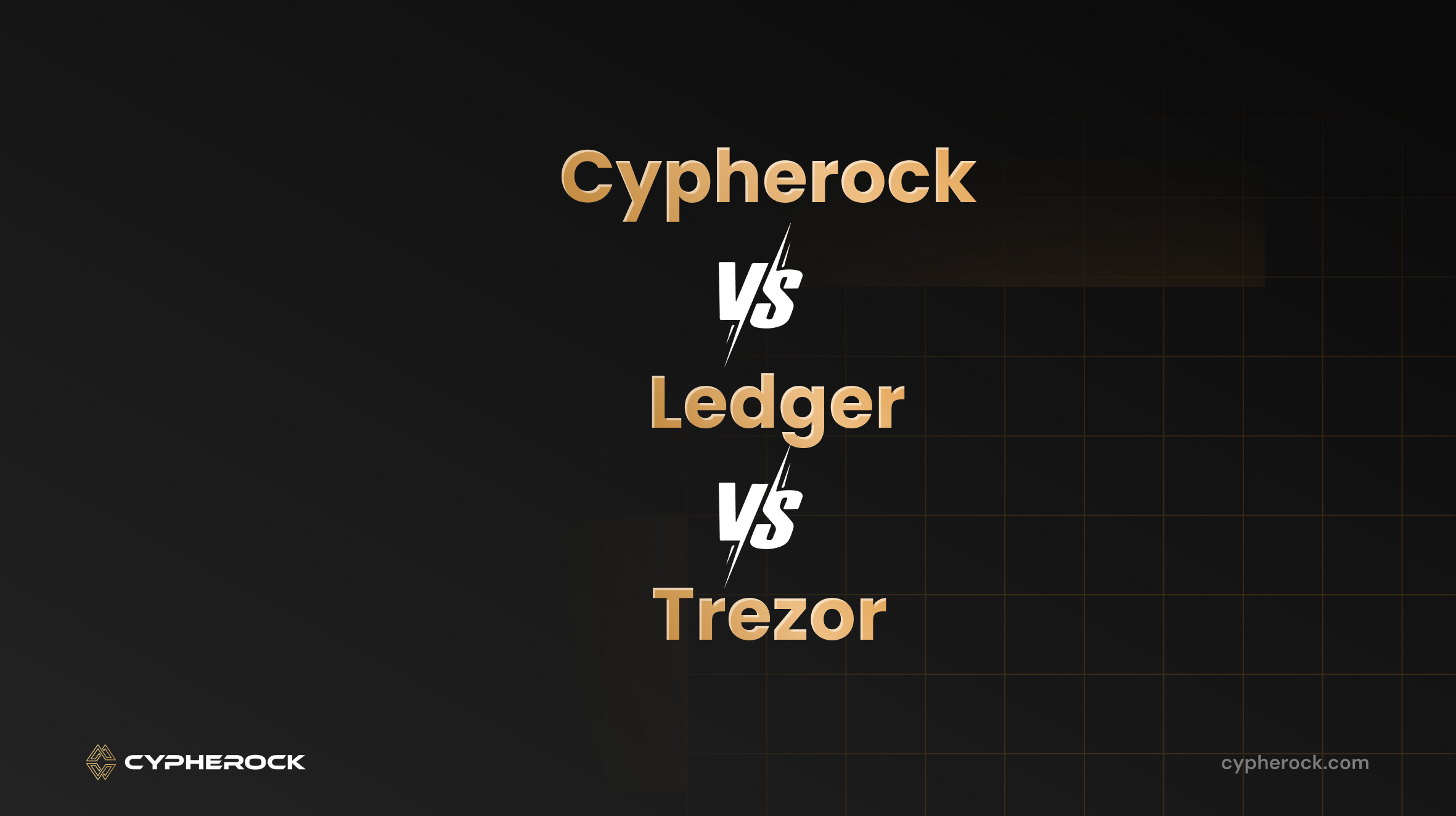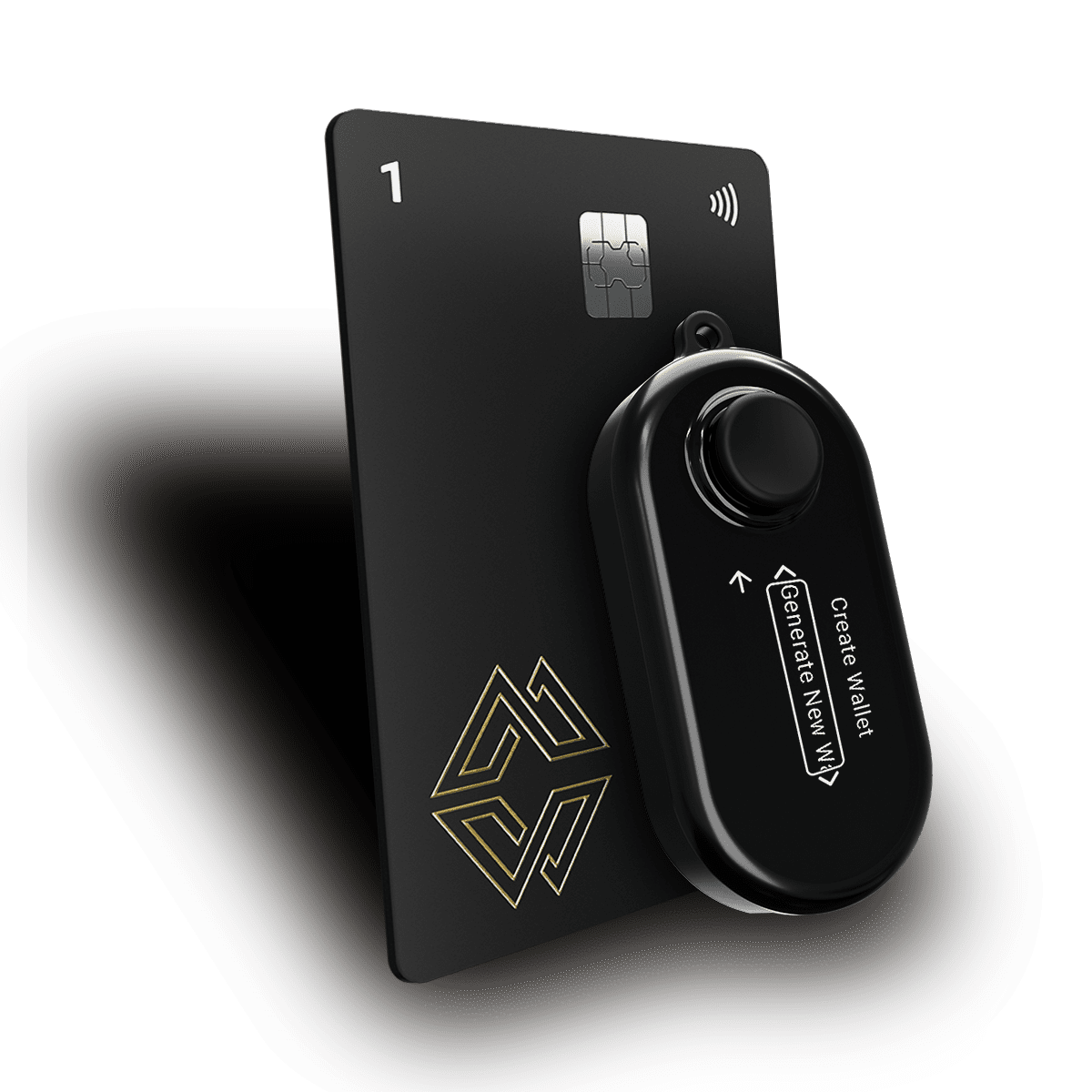

Choosing the best hardware wallet to store your cryptocurrency can be a confusing decision. With so many options available, how do you know which one is the right fit for your needs? Among the most popular options, Trezor, Ledger, and Cypherock stand out, each offering unique features, advantages, and drawbacks.
In this article, we'll break down these hardware wallets and compare Trezor vs Ledger vs Cypherock to help you decide which one is the best for securing your crypto assets.
When selecting a hardware wallet, how it feels in your hand and how you interact with it can make a big difference, especially when you need to manage your assets securely and frequently. Let’s look at the design of each wallet.
The Cypherock X1 offers a unique multi-component design. It consists of a main wallet and four X1 Cards, which split your private keys into secure pieces. This allows you to use just one part and your wallet to perform transactions, making it flexible and secure. The design may feel a bit different at first, but it’s highly secure and novel.
Trezor is known for its simple yet robust design. The Trezor Model T, the more advanced model, has a touch screen, making it intuitive to use. It’s compact and straightforward, with a focus on ease of use, making it great for those new to hardware wallets.
Ledger's design is sleek and compact. Both the Ledger Nano X and Nano S have a minimalist, portable feel. The buttons on the Nano S can be a bit small, but overall, the wallets are solid, practical, and comfortable to hold. The Nano X has Bluetooth capability, adding a layer of convenience for mobile users.
Security is the most important factor when choosing a hardware wallet, as it determines the safety of your cryptocurrency assets.
Cypherock X1 uses a multi-component design that doesn’t rely on a traditional seed phrase backup. The device splits private keys across the wallet and four separate X1 Cards. Even if you lose three of the parts, your funds remain safe. The addition of a PIN during setup ensures an extra layer of security. It’s one of the most secure hardware wallets available because of this distributed key management system.
On top of that, Cypherock is audited by Kelabs, the same firm that has found vulnerabilities in both the Ledger and Trezor.
Trezor is a highly secure option but uses a 24-word seed phrase to backup your keys. While this method is widely regarded as secure, it’s also prone to physical damage or theft if the backup is not properly stored. The Trezor Model T also supports two-factor authentication for added security.
However, Kraken Security Labs discovered a critical vulnerability in Trezor hardware wallets involving voltage glitching to extract an encrypted seed, potentially compromising the device’s security. This finding emphasizes the importance of enhanced protection measures in hardware wallets. Read more...
Ledger provides robust security with its use of a secure chip to isolate private keys. However, like Trezor, it relies on a 24-word seed phrase backup. In 2023, Ledger experienced a significant data breach, where customer data was exposed. While this didn’t directly affect the security of the hardware wallet itself, it raised concerns about Ledger’s overall data protection protocols.
In 2023, Ledger experienced a significant breach where customer data was compromised due to a hack exposing personal details linked to customers' crypto wallets. Although the breach did not directly impact the wallet’s core security, it raised concerns about potential data leaks and the need for comprehensive security measures beyond the device itself. Learn more...
Losing your wallet or losing access to your private keys can be a nightmare. Here's how each wallet handles backup and recovery.
With Cypherock, you don’t have to worry about seed phrases at all. The backup system is more sophisticated. If you lose the X1 wallet or several of the X1 Cards, you can still recover your crypto. This backup and recovery method is far more advanced compared to other wallets, which still rely on traditional seed phrase backups.
Trezor’s recovery process is based on the standard 24-word seed phrase. If you lose your device, you can restore your wallet using the backup phrase on a new Trezor device. This is a reliable method but relies entirely on the security of the seed phrase.
Ledger also uses the 24-word seed phrase for backup. It’s a reliable method as long as the seed phrase is securely stored and not compromised. Like Trezor, losing your Ledger device doesn’t mean losing your crypto, as long as you have your backup phrase.
Also Learn: How Cypherock Protects Your Seed Phrase From Theft and Loss?
Ease of use is an important consideration, especially for newcomers to cryptocurrency.
Cypherock X1 may take a little longer to get used to because of its multi-component design. You need to familiarize yourself with how to use the X1 Cards alongside the wallet. Once you understand the system, though, it is easy to use. The CySync app for portfolio management makes the entire experience user-friendly.
Trezor offers one of the most straightforward user experiences. The touch screen on the Trezor Model T makes navigation smooth, and it’s simple to connect the wallet to the Trezor Suite software. It’s a great option for beginners who want to get started quickly.
Ledger’s interface is also very user-friendly, especially with the Ledger Live app, which provides a simple dashboard for managing your portfolio and transactions. However, the Nano S requires more manual input with buttons, which can be a bit cumbersome compared to the Trezor Model T’s touchscreen.
Firmware transparency is crucial for ensuring that the software running your wallet is secure and free from vulnerabilities.
Cypherock has made its X1 wallet code open for review, which is a significant advantage for security-conscious users. However, the code for the X1 Cards remains proprietary, ensuring the security of your keys across different components.
Trezor is fully open-source, and its firmware is available for anyone to audit. This level of transparency is great for users who value open-source projects and want to ensure there are no backdoors or vulnerabilities in the software.
Ledger is partially open-source. Its firmware and applications are available on GitHub for independent review. However, its hardware design is not open-source, which has been a point of contention for some in the security community.
Cryptocurrency compatibility is another important factor when selecting a hardware wallet.
Cypherock supports a wide range of cryptocurrencies and is designed to work with multiple operating systems, including Windows, MacOS, Linux, and mobile devices. This makes it an excellent choice for users with diverse crypto portfolios.
Trezor supports a wide variety of coins and tokens, including Bitcoin, Ethereum, Litecoin, and many altcoins. The wallet is constantly updated to support new coins as they become available on the market.
Ledger supports a vast array of cryptocurrencies, including Bitcoin, Ethereum, and a large number of altcoins. Ledger’s software, Ledger Live, is regularly updated to ensure compatibility with new tokens.
The companion apps help you manage your crypto assets, track prices, and send transactions.
Cypherock’s CySync app is easy to use and offers an all-in-one solution for portfolio management, transaction tracking, and security features. It’s an excellent tool for both beginners and advanced users.
Trezor’s Trezor Suite provides a clean and easy-to-navigate interface for managing your crypto assets. It offers features such as portfolio tracking, transaction history, and the ability to manage multiple accounts.
Ledger Live is Ledger’s companion app, and it’s intuitive and well-designed. The app provides real-time portfolio tracking, transaction management, and integrates easily with third-party apps like Binance and Kraken.
If you want to ensure your assets are passed down securely, inheritance options are something to consider.
Cypherock allows you to divide your private key into several parts and distribute them to different people. This is particularly useful for inheritance planning, ensuring that your crypto assets can be accessed by your heirs after your passing.
Trezor uses Shamir Backup, which allows users to divide their seed phrase into multiple parts and store them in different locations. This is useful for inheritance and recovery purposes.
Ledger does not offer a formal inheritance feature. Users are responsible for ensuring their recovery phrase is accessible to their heirs. The Legacy Contact feature allows users to designate a contact who can access their account in the event of loss.
Pros:
Cons:
Pros:
Cons:
Pros:
Cons:
Choosing between Cypherock X1, Trezor, and Ledger depends on your needs.
No matter which wallet you choose, make sure to follow best security practices and back up your recovery information safely. Each of these wallets offers robust protection for your crypto assets.

Start securing your crypto journey today—visit Cypherock X1 to learn more.
Connect with us:
Twitter: @CypherockWalletTelegram: Join the Community
